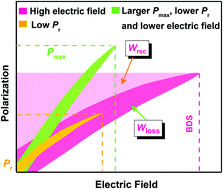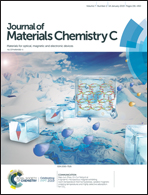Enhanced energy-storage performance with excellent stability under low electric fields in BNT–ST relaxor ferroelectric ceramics
Abstract
Relaxor ferroelectrics are promising candidates for pulsed power dielectric capacitor applications because of their excellent energy-storage properties. Different from most relaxor ferroelectrics whose energy-storage density was improved by increasing the breakdown strength and reducing the remanent polarization, in this study, anti-ferroelectric (AFE) AgNbO3 (AN) was used to partially substitute the relaxor ferroelectric 0.76Bi0.5Na0.5TiO3–0.24SrTiO3 (BNT–ST) of morphotropic phase boundary (MPB) composition to reduce the remanent polarization while maintaining large maximum polarization. In this way, a large recoverable energy-storage density (2.03 J cm−3) was obtained in the BNT–ST–5AN ceramics under lower electric field of 120 kV cm−1, which is superior to other lead-free energy-storage materials under similar electric fields. Moreover, excellent temperature (25–175 °C) and frequency (1–100 Hz) stabilities are achieved. This performance demonstrates that the BNT–ST–5AN ceramics form a promising class of dielectric capacitive material for high-temperature pulsed power capacitors with large energy-storage density.

- This article is part of the themed collections: 10th Anniversary: Most popular articles and 2019 Journal of Materials Chemistry C Most Popular Articles


 Please wait while we load your content...
Please wait while we load your content...